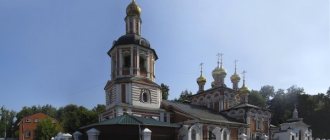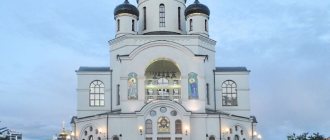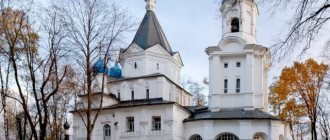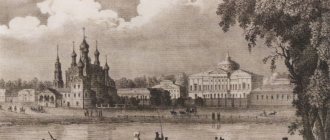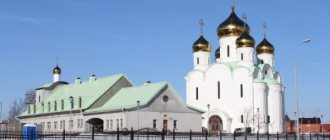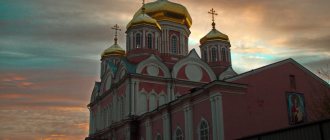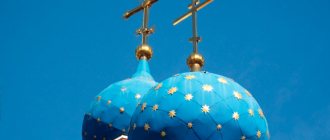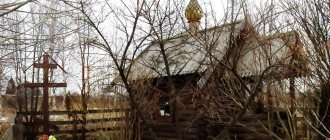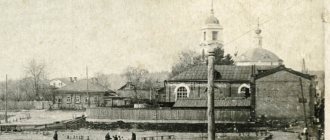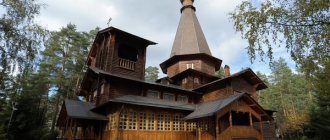Mir
Russia Moscow Church of St. Seraphim of Sarov in Kuntsevo (Moscow) Map is loading...
{"format":"leaflet","minzoom":false,"maxzoom":false,"limit":50,"offset":0,"link":"all","sort":[""], "order":[],"headers":"show","mainlabel":"","intro":"","outro":"","searchlabel":"\u2026 \u0441\u043b\u0435\ u0434\u0443\u044e\u0449\u0438\u0435 \u0440\u0435\u0437\u0443\u043b\u044c\u0442\u0430\u0442\u044b","default":"","import-annotation":false,"width ":"auto","height":"350px","centre":{"text":"","title":"""link":"""lat":55.72305999999999670535544282756745815277099609375,"lon": 37.4336100000000016052581486292183399200439453125,"icon":""},"title":"","label":"","icon":"","lines":[],"polygons":[],"circles":[ ],"rectangles":[],"copycoords":false,"static":false,"zoom":8,"defzoom":14,"layers":["OpenStreetMap"],"image layers":[] ,"overlays":[],"resizable":false,"fullscreen":true,"scrollwheelzoom":true,"cluster":false,"clustermaxzoom":9,"clusterzoomonclick":true,"clustermaxradius":80, "clusterspiderfy":true,"geojson":"","clicktarget":"","showtitle":true,"hidenamespace":false,"template":"","userparam":"","activeicon": "","pagelabel":false,"ajaxcoordproperty":"","ajaxquery":"","locations":[{"text":"\u003Cb\u003E\u003Ca href=\"/palomnik/%D0% A5%D1%80%D0%B0%D0%BC_%D0%BF%D1%80%D0%B5%D0%BF%D0%BE%D0%B4%D0%BE%D0%B1%D0%BD% D0%BE%D0%B3%D0%BE_%D0%A1%D0%B5%D1%80%D0%B0%D1%84%D0%B8%D0%BC%D0%B0_%D0%A1%D0% B0%D1%80%D0%BE%D0%B2%D1%81%D0%BA%D0%BE%D0%B3%D0%BE_%D0%B2_%D0%9A%D1%83%D0%BD% D1%86%D0%B5%D0%B2%D0%B5_(%D0%9C%D0%BE%D1%81%D0%BA%D0%B2%D0%B0)\» title=\»\u0425\ u0440\u0430\u043c \u043f\u0440\u0435\u043f\u043e\u0434\u043e\u0431\u043d\u043e\u0433\u043e \u0421\u0435\u0440\u0430\u0444\u0 438\u043c\u0430\u0421\u0430\ u0440\u043e\u0432\u0441\u043a\u043e\u0433\u043e \u0432 \u041a\u0443\u043d\u0446\u0435\u0432\u0435 (\u041c\u043e\u0441\u043a\u 0432\u0430)\»\u003E\ u0425\u0440\u0430\u043c \u043f\u0440\u0435\u043f\u043e\u0434\u043e\u0431\u043d\u043e\u0433\u043e \u0421\u0435\u0440\u0430\u0 444\u0438\u043c\u0430\u0421\ u0430\u0440\u043e\u0432\u0441\u043a\u043e\u0433\u043e \u0432 \u041a\u0443\u043d\u0446\u0435\u0432\u0435 (\u041c\u043e\u0441\u 043a\u0432\u0430)\u003C/ a\u003E\u003C/b\u003E\u003Chr /\u003E\u003Ca href=\»/palomnik/%D0%A1%D0%B2%D0%BE%D0%B9%D1%81%D1%82%D0% B2%D0%BE:%D0%90%D0%BD%D0%BD%D0%BE%D1%82%D0%B0%D1%86%D0%B8%D1%8F\» title=\»\u0421 \u0432\u043e\u0439\u0441\u0442\u0432\u043e:\u0410\u043d\u043d\u043e\u0442\u0430\u0446\u0438\u044f\u003E\u0410\u043d\u043d \u043e\u0442\u0430\ u0446\u0438\u044f\u003C/a\u003E: »'\u0425\u0440\u0430\u043c \u041f\u0440\u0435\u043f\u043e\u0434\u043e\u0431\u043d\u043e\u04 33\u043e\u0421\u0435 "smw-highlighter" \» data-type=\ "2\" data-state=\"persistent\" data-title=\"\u0418\u043d\u0444\u043e\u0440\u043c\u0430\u0446\u0438\u044f\" title=\"\u0026#039; \u0026#039;\u0026#039;\u0425\u0440\u0430\u043c\u041f\u0440\u0435\u043f\u043e\u0434\u043e\u0431\u043d\u043e\u0433\u043e\u0 421\u0435\u0440\u0430 \u0444\u0438\u043c\u0430 \u0421\u0430\u0440\u043e\u0432\u0441\u043a\u043e\u0433\u043e \u0432 \u041a\u0443\u043d\u0446\u0435 \u0432\u0435\u0026#039;\ u0026#039;\u0026#039; 2014 5\u043e\u0434\u0438\u0442\ u0441\u044f \u0440\u044f\u0434\u043e\u043c \u0441 71-\u0439 \u0433\u043e\u0440\u043e\u0434\u0441\u043a\u043e\u0439 \u043a\u0 43b\u0438\u043d\u0438\u0447\ u0435\u0441\u043a\u043e\u0439 \u0431\u043e\u043b\u044c\u043d\u0438\u0446\u0435\u0439. 2000 31 31 43b\u0430\u043f\u043e\u0434\u0432 \u043e\u0440\u044c\u0435\u043c \u0421\u0430\u0432\u0432\u0438\u043d\u043e-\u0421\u0442\u0430\u0440\u043e\u0436\u0435\u0432\ u0441\u043a\u043e\u0433\ u043e\u043c\u043e\u043d\u0430\u0441\u0442\u044b\u0440\u044f. 2006 2006 \u0435\u043d \u0441\u0442\u0430\ u0442\u0443\u0441 \u041f\u0430\u0442\u0440\u0438\u0430\u0440\u0448\u0435\u0433\u043e \u043f\u043e\u0434\u0432\u043e\u0440\u0 44c\u044f.\»\u003E\u003Cspan class=\»smwtext\»\u003E\u2026 \u003C/span\u003E\u003Cspan class=\»smwttcontent\»\u003E»'\u0425\u0440\u0430\u043c \u041f\u0440\u0435\u043f\u043e\u 0434 \u043e\u0431\u043d\u043e\u0433\u043e \u0421\u0435\u0440\u0430\u0444\u0438\u043c\u0430 \u0421\u0430\u0440\u043e\u0432\u0441\ u043a\u043e\u0433\u043e\u0432 '' 9\u0445\u0440\u0430\u043c ,\u043d\u0430\u0445\u043e\u0434\u0438\u0442\u0441\u044f\u0440\u044f\u0434\u043e\u043c\u0441 71-\u0439 \u043e\u0434\u0441\u043a\ u043e\u0439 \u043a\u043b\u0438\u043d\u0438\u0447\u0435\u0441\u043a\u043e\u0439 \u0431\u043e\u043b\u044c\u043d\u0438\u0446\u0 435\u0439. 2000 31 31 43b\u0430\u043f\u043e\u0434\u0432 \u043e\u0440\u044c\u0435\u043c \u0421\u0430\u0432\u0432\u0438\u043d\u043e-\u0421\u0442\u0430\u0440\u043e\u0436\u0435\u0432\ u0441\u043a\u043e\u0433\ u043e\u043c\u043e\u043d\u0430\u0441\u0442\u044b\u0440\u044f. 2006 2006 \u0435\u043d \u0441\u0442\u0430\ u0442\u0443\u0441 \u041f\u0430\u0442\u0440\u0438\u0430\u0440\u0448\u0435\u0433\u043e \u043f\u043e\u0434\u0432\u043e\u0440\u0 44c\u044f.\u003C/span\u003E \u003C/span\u003E \u0431\u044b\u043b \u043f\u0440\u0438\u0441\u0432\u043e\u0435\u043d \u0441\u0442\u0430\u0442\u0443\u0441 \u 041f\u0430\u0442\u0440\u0438 \u0430\u0440\u0448\u0435\u0433\u043e \u043f\u043e\u0434\u0432\u043e\u0440\u044c\u044f.","title":"\u0425\u0440\u0430\u043c \u043f \u0440\u0435 \u043f\u043e\u0434\u043e\u0431\u043d\u043e\u0433\u043e \u0421\u0435\u0440\u0430\u0444\u0438\u043c\u0430 \u0421\u0430\u0440\ u043e\u0432\u0441\u043a\u043e \u0433\u043e \u0432 \u041a\u0443\u043d\u0446\u0435\u0432\u0435 (\u041c\u043e\u0441\u043a\u0432\u0430)","link":"""lat":55.723059999 99999670535544282756745815277099609375," lon":37.4336100000000016052581486292183399200439453125,"icon":""}],"imageLayers":[]}
55.722963; 37.433624
Russia, Moscow, Bagritskogo street, 10k3s6
Moscow
Russia
Telephone:
(495) 440-84-73
Temple of St. Seraphim of Sarov in Kuntsevo
- an Orthodox church, located next to the 71st city clinical hospital. In 2000, on May 31, the church became the courtyard of the Savvino-Starozhevsky Monastery. In 2006, the temple was given the status of a Patriarchal metochion.
Who is it named after, the significance of the temple today
The Temple of Seraphim of Sarov in Raev received its name in honor of the main altar, consecrated in honor of the saint of the Russian land. Saint Seraphim was the founder and patron of the Diveyevo Convent and is revered as one of the most famous monks in the history of the Russian Orthodox Church. It is known that he was born in 1754, and in 1778 he became a novice in the Sarov wasteland.
Various hagiographies mention various stories from his childhood: one says that he fell from a bell tower and was saved by an angel, and another says that he became seriously ill and the Mother of God granted him healing during a religious procession. In 1786, Seraphim became a monk and soon began to live in solitude, as he always had a penchant for silence and the Jesus Prayer.
The description of his life preserved that he lived in a separate cell, where he was engaged in ascetic exercises, reading sacred books, and working in his own garden and beehives. His feat of pillar-bearing is also known, where the saint spent 1,000 days and nights on a boulder in unceasing prayer.
It is also noteworthy from his life that wild animals came to him, in particular, a bear, which the saint fed bread from his hands.
Many people of various classes came to Seraphim for spiritual guidance and advice, from whom he always refused to take anything as a reward or gratitude. The life describes a case of how one day thieves, deciding that the saint was hiding wealth in his cell, beat him and wanted to rob him, but found nothing.
After their attack, Seraphim received a back injury and remained hunched over forever, but he never held a grudge against anyone and forbade punishing his offenders. From 1807 to 1825, the saint accepted the feat of silence and seclusion, and after that he received the gift of clairvoyance and healing of illnesses.
The life of the saint was rewritten many times to make it comply with censorship, and during another edition new episodes were added, the truth of which is doubtful. The issue of canonization also caused problems due to the attitude of Saint Seraphim towards the Old Believers, since his own words or written instructions on this matter have not been preserved.
Today, the temple in Raev is not only a church in which believers can become participants in the sacraments, it is also a cultural center aimed primarily at young people.
In this area of Moscow there are many recently completed houses inhabited by young families, so the temple and its youth association become an important religious and moral beacon, providing the opportunity for social work and participation in the life of the city.
Igumensky building
To the left of the bell tower is the abbot's building. The place for the abbot's corps was indicated by the Monk Seraphim according to the instructions of the Blessed Virgin.
In fact, this is an administrative building combined with a library. It also housed the bishop's and abbot's chambers, as well as the cells of the nunnery's officials. Father called it “the command corps.”
This is a rather large old two-story building in the shape of the letter “P”. Its two wings surround the courtyard. The constructed building had 7 wooden porches, 190 windows, and 48 stoves. There was its own house church named after Mary Magdalene. Such is the scale!
The Abbot's building is also interesting from an architectural point of view. This is a wonderful house in pseudo-Russian style. The unusual porch gives special expressiveness to the façade. It is inscribed in a two-story bay window (the protruding part of the building), which ends with flirty “kokoshniks”.
Under Soviet rule, the building was ruined. Recently, extensive restoration work has been carried out.
Today the building looks very homely and cozy. Decorated in the best traditions of Russian wooden buildings.
The two-story blue building is extremely elegant. The trim is made of white carved wooden lace. The white frames of the windows are very expressive. The restored bay window looks like something out of a fairy tale.
The temple was also restored and re-consecrated. But outsiders are not allowed into the services.
We will also tell you later about the interesting history of the church in the name of St. Mary Magdalene, Equal-to-the-Apostles.
Architect, exterior decoration, architectural ensemble
Today the temple is a large-scale architectural complex. In addition to the temple building, there is a separate baptismal church, utility buildings, a Sunday school building, workshops and a spiritual and educational center building. From a distance, the temple ensemble can be mistaken for a monastery building.
The architect and author of the project was A. A. Mamonov, a famous artist and participant in Project-200.
More than 15 temples from the list have already been built according to his designs, and construction continues. In his works, A. A. Mamonov focuses on various stylistic and practical solutions, based on historical styles in the construction of the temple and at the same time using elements of modern architecture.
The height of the temple is 43 m, the total area is more than 1,000 square meters. m, the temple is in keeping with the traditions of Russian architecture and was built according to the models of ancient Russian churches. The temple has an unusual dark roof and three onion domes: one central and two on the side aisles.
The temple is divided into three apses and has an upper and lower temple. Externally, the temple is covered with white facing material. The domes are covered with a dark roof. There are architectural decorations on the walls, window sills and tops of the windows.
Ditch in Diveevo
The confessor of the monastery, Saint Seraphim of Sarov, had a vision of the Mother of God passing with prayer in Diveevo along a special path, and then he received instructions to dig a ditch with a shaft in this place. The saints said that every night the Mother of God prays on Kanavka. That is why they don’t just walk along the Holy Kanavka, but walk with the prayer “Virgin Mother of God, Rejoice.” You need to read this prayer 150 times, and many feel peace and tranquility during this journey.
Throughout its history, Kanavka has experienced construction, destruction and restoration.
At the moment, this structure is a ditch, has a length of 777 meters and a depth of human height. Its slopes are lined with turf and gooseberries. The Kanavka shaft itself, along which people walk, is paved with paving stones and surrounded by a fence
History of construction
The village of Raevo was first mentioned in chronicles of the 17th century. It is known for certain that a village church was built here, but destroyed during the Time of Troubles. In 1682, through the efforts of local residents, it was restored and existed until 1794, where it was finally dismantled due to the old age and danger of the structure.
The parish in Raevo was disbanded and assigned to the church in the neighboring village. The village was inherited and resold many times, was a stopping place for pilgrims on the way to the Lavra, and then became an important strategic site: artillery warehouses were located here, and later a railway was built.
All this contributed to the expansion of the village into a settlement in which many Muscovites built their country houses. There was no longer a church here, but the place of the church stone was marked by a chapel built here. Now the old Raevskoye cemetery was located here, and it existed until about the 1920s.
During the revolution, information about the cemetery and burials was lost and was not displayed on the city map, and the chapel was also destroyed at the same time. In 1960, the village of Raevo became part of the city of Moscow. The construction of a new church in Raevo began in 2003 and dragged on for a long time, as it was built exclusively with community money and donations.
A temporary baptismal church was built here, in which services were held during the main construction. Construction received a new impetus in 2010, when, with the blessing of the Patriarch, “Program 200” was launched.
This program for the construction of 200 churches in Moscow was created in such a way as to place 1 church per 20,000 people within the city, taking into account its walking distance within 1 km. A support fund was organized to collect and redistribute funds received from benefactors.
In 2010, the temple under construction was included in the program, and based on the results of the off-site meeting, the site was recognized as the largest construction project within the program. Thanks to help and donations, the construction of the temple accelerated and in 2011 a cross was installed on the dome.
Various construction and interior design work continued, and in parallel with the temple, the construction of the entire spiritual complex was carried out at once. In 2014, the consecration of the side chapel of the temple in honor of St. Nicholas took place, in 2021 - the minor consecration of the temple, in 2021 the construction was completely completed, the temple was fully consecrated and began its permanent work.
Don’t miss the most popular article in the section: Optina Pustyn Monastery - how to get there from Moscow, address, where it is located, history and interesting facts.
Holy springs
Diveevo is also rich in holy springs. They are located not only in the village itself, but also in its surroundings. Each source has its own history of origin. The water in them is not only clean and tasty, but also healing. People plunge into the springs with prayer, collect it in containers and take it with them. There are many recorded accounts of healing from various diseases.
Interior decoration
The Temple of Seraphim of Sarov in Raev is made in white colors. The lower temple, where morning services are held, has a relatively low ceiling and wide supporting columns with gentle semi-arches, creating the illusion of a temple located in a stone basement. In the lower church there is an unusual iconostasis with two rows of icons, half made of stone and half made of wood.
Church of Seraphim of Sarov in Raev interior decoration.
Here soft white tones are maintained in everything, from the shade of the walls to the shade of the stone. The marble floor, assembled from white and beige squares with a pronounced tile pattern, is especially beautiful. The floor is divided into sectors and separated by a border of even darker shades.
In the upper church the same canonical consistency of style is preserved. The iconostasis here is not high: one high tier and one short, without a high rise. The icons for it were painted by new masters, the iconostasis itself is decorated with floral patterns, gold, and bright color accents. The inside of the temple is not painted, but it is decorated with icons placed on the walls.
Useful tips for pilgrims and tourists
When planning to visit the Diveyevo Monastery, take with you:
- containers for collecting water from 6 healing springs;
- bags for folding wet clothes after swimming;
- towel;
- packaging for soil from the groove, crackers;
- bottle for oil.
Car parking is available in the free parking lot to the right of the main entrance to the monastery. They also park on the side of the road directly along the road along which they go to the monastery.
The rules of behavior on the territory of the Seraphim of Sarov Monastery are presented on a poster that greets you at the entrance.
Silence is maintained here. Gadgets are put on silent mode or turned off. Maintain cleanliness and routine, do not smoke or drink alcohol. Children visit the monastery only with adults.
Women visit the shrine wearing a skirt or dress. Length – below the knees, sleeves covering the elbows. The head must be covered. Bright makeup and jewelry are not allowed. Men are allowed to visit in trousers and shirts. Baptized people must wear a cross.
When performing services, they do not go to churches. They stand and, if desired, quietly sing along with the choir. The sick and weak sit on benches.
They take photographs and film for free on phones and tablets. Filming with video cameras and cameras is carried out by purchasing a coupon at the pilgrimage center. Journalists and film crews must purchase permission for professional work from the press service of the Nizhny Novgorod and Arzamas diocese.
People approach shrines with prayer. They cross themselves at the holy relics, bow twice, venerate, then bow again. People do not linger long at the shrines to which people stand in line.
Clergy and mentors
The Church of Seraphim of Sarov in Raev has a full-fledged parish staff. The rector of the church today is Archpriest Alexey (Yakovlev), a candidate of theology, the head of the project for the revival of wooden churches of the North and a teacher of Orthodox culture at the Moscow Military Academy.
The second priest is Hieromonk Nikodim (Dorozhkin), winner of the Sergius of Radonezh medal, 1st degree, for his services and contribution to the development of the church. Priests Nikolai (Zorin), Nikita (Ivanov) and Grigory (Shinov) also serve at the temple. All priests are engaged in social work, Sunday school, perform divine services, and have church awards.
Social work, everyday life
The Church of Seraphim of Sarov in Raev carries out active social work. In addition to targeted assistance to large families, there is food and clothing assistance for children from orphanages, elderly people, and regional clubs for low-income families. The church holds services for children with disabilities.
An Orthodox psychologist works for people with problems of various types of addiction, group meetings and individual lessons are organized. The parish regularly takes part in “Get your child ready for school” events and organizes charity fairs.
Celebrations are held for children from the Petrovsky orphanage with the participation of Sunday school pupils.
The parish works with prisoners within the framework of a correspondence Sunday school. The school staff corresponds and conducts Orthodox courses, helping prisoners to come to Orthodoxy, understand their actions and lead a spiritual life. The parish publishes a weekly church newspaper with news and a schedule of services.
What time to visit the monastery
People rush to the shrines at the call of their hearts exactly when they should be here. The timing of the trip is also chosen based on priority desires. The nature of the monastery reflects the natural beauty of all seasons. Therefore, you can opt to visit the monastery during your favorite season.
From May to September the opportunity to swim in healing springs is added. The mildest months for this are May and September. In May, mosquitoes appear near the water, people stock up on protective equipment. If it is more important to take part in special events or memorable ones, get acquainted with the Orthodox calendar in advance.
The monastery is crowded on weekends and church holidays. Therefore, it is better for those who like less crowds to visit the days when multi-day fasts take place. During such periods, fewer festive events are held, and the influx of pilgrims decreases accordingly.
There is less influx of people, slightly lower prices, discounts and promotions are organized more often in the winter months. The exception is during the New Year holidays.
Sunday School
On the territory of the temple there is a Sunday school for children from 5 to 14 years old. Main classes take place on Saturdays and Sundays. Children study the basics of Liturgics, the Law of God, the basics of church singing, receive vocal and solfeggio lessons, and study the Church Slavonic language.
For convenience, children are divided into classes according to their age. The Sunday school hosts a variety of courses and clubs: a carpentry workshop, knitting and embroidery lessons, a theater studio, and a children's choir.
There is also a Sunday school for adults at the church: catechesis is held here, conversations are held with those who have just been baptized and planning to be baptized, the basics of faith are taught, as well as meetings with various people from various fields of science and art and participants in various projects.
Service schedule, operating hours
The temple is open from 7:30 to 21:00 on weekdays and Saturdays, and from 6:30 to 21:00 on Sundays.
| weekdays | 7:40 – Divine Liturgy 16:45 – evening service |
| Saturday | 6:40 – early Divine Liturgy 8:00 – memorial service 15:00 – prayer service with akathist 16:45 – evening service |
| Sunday | 6:40 – early Divine Liturgy 8:00 – water prayer service 9:40 – late Divine Liturgy 16:45 – evening service with akathist |
Information for pilgrims
On weekdays, the upper church is closed and services are held only in the lower church. Access to the upper temple is allowed only with the blessing of the priest. Photo and video filming during services is not permitted in the temple.
There is a library and a bookstore at the temple; it is possible to purchase icons and books, order various services, such as the magpie or the psalter.
Cultural life of the monastery
It is probably strange to touch on this topic in a story about a spiritual monastery. But, nevertheless, there is something to be said here.
The Seraphim-Diveevo Monastery has its own printing house, where they print books of spiritual content and a magazine. There is a museum of Pasha of Sarov - the blessed Diveyevo. In the lobby of the abbot's building there is an exposition of the photo chronicle of the monastery. An Orthodox gymnasium has been operating at the monastery for several decades.
There is a cultural and educational center and its own library. There are hotels for pilgrims.
Where is it located, what is in the surrounding area, how to get there
Not far from the Church of Seraphim of Sarov there is the Medvedkovo metro station. The journey from the station to the temple will take approximately 10-15 minutes on foot. Shuttle buses also go towards Raevo, stopping opposite the temple, these are routes No. 50, No. 166, No. 412, No. 554. The temple is tall enough to serve as a landmark.
Near the temple there is the Yauza River, the Suvorov Military School and an eco-park, open 24 hours a day, with recreational facilities, bike rental, paths and access to the water. The Church of Seraphim of Sarov is a young and at the same time very promising temple and parish, aimed at various social work, helping those in need and constant interaction with young people.
For Raevo, the temple became a kind of religious “pearl”, a spiritual landmark, and a place for communication with others.
Author: Katya Volkova
Article design: Oleg Lozinsky
